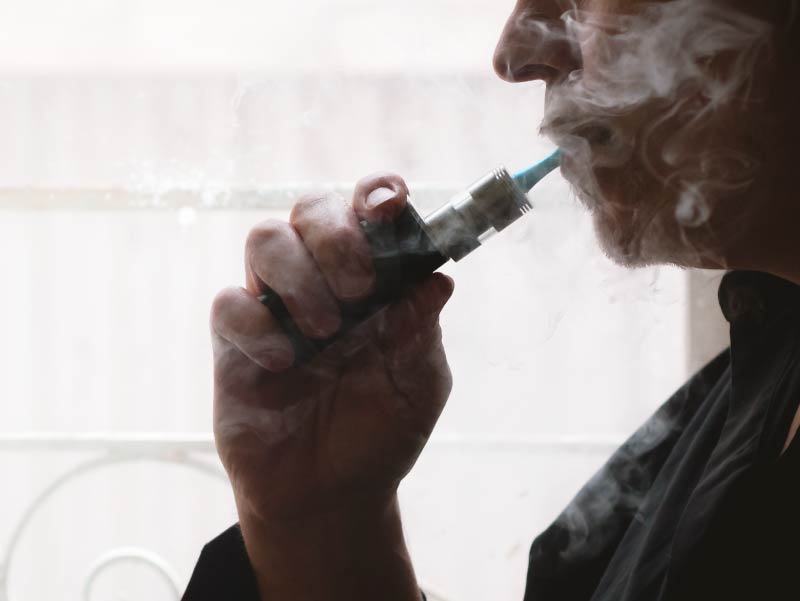Dramatic rise of e-cigarettes and new tobacco products poses major public health concern
By American Heart Association News

Although cigarette smoking rates have hit an all-time low in the United States, the use of e-cigarettes and newer tobacco products is on the rise – especially among young people – and is threatening to undo decades of tobacco control efforts, according to a new report.
"With new products on the market, everything is on the upswing. Kids are using nicotine products as much now as in the 1990s," said Aruni Bhatnagar, lead author of the American Heart Association presidential advisory published Wednesday in the journal Circulation. "There's concern that we're addicting a whole new generation to nicotine."
AHA presidential advisories review the landscape of urgent public health issues. This latest advisory takes a comprehensive look at all new tobacco products, including e-cigarettes, hookah, cigars and cigarillos, and offers new insights based on the latest usage data and evidence.
"We need to look at products within the context of the overall goal of reducing or eliminating nicotine and tobacco use in our society," said Bhatnagar, a professor of medicine at the University of Louisville School of Medicine.
In particular, the advisory notes e-cigarettes are now the most popular tobacco product among youth in the United States. An estimated 3.1 million high school students, or 20.8 percent, used e-cigarettes in 2018, compared to 22,000 students, or 1.5 percent, in 2011. Between 2017 and 2018 alone, 1.5 million more young people used e-cigarettes – a 78 percent increase in use among high school students and a nearly 50 percent increase in use among middle school students.
Experts are concerned vaping serves as a gateway to other unhealthy behaviors.
"E-cigarettes are the primary driver of recent increases in overall tobacco product use," said Brian King, deputy director for research translation in the Centers for Disease Control and Prevention's Office on Smoking and Health. "As the use of e-cigarettes has increased, cigarette smoking rates have stalled. Rates have stagnated for the last three years."
Tobacco companies have marketed e-cigarettes and other newer tobacco products as being cool, especially on social media. These products also are perceived as less harmful compared to cigarettes. "Anti-tobacco campaigns succeeded by denormalizing smoking," Bhatnagar said. "With these new products, tobacco companies have renormalized the use of tobacco and made it cool again."
There's concern that these new products may make it easier for kids to start smoking and use multiple forms of tobacco and nicotine.
King said e-cigarettes such as Juul can deliver a far higher concentration of highly addictive nicotine than most other e-cigarettes. The Juul refills, called pods, can contain the same amount of nicotine as 20 cigarettes. Plus, e-cigarettes with fruit or candy flavors can be especially appealing to young people. Research also shows e-cigarette users are more likely to use drugs or alcohol.
Experts say knowledge and research on new tobacco products is emerging – and needs to continue.
"We need to better understand how these products affect cardiovascular health and heart disease," Bhatnagar said.
King said there's a need for better surveillance of use too, particularly among youth. "The tobacco control and public health community needs to remain nimble and reflect the diversity of tobacco products people are using," he said.
The advisory calls for a comprehensive approach among multiple organizations to reduce tobacco use rates to less than 5 percent.
Recommendations include strong regulation of tobacco products by the Food and Drug Administration, including banning flavorings and restricting marketing and advertising, particularly aimed at young adults; continued regulation at the state and local levels using proven tobacco-control strategies; ongoing education for health care providers; and coordinated regulatory efforts on a global level to reduce and prevent tobacco use.
"Although there are claims that there is a whole continuum of harm, no tobacco product is without harm," Bhatnagar said. "It's easy to get trapped in nicotine addiction no matter with which product you start. We want to send a strong cautionary note against the use of any tobacco product, especially among youth."
If you have questions or comments about this story, please email [email protected].





